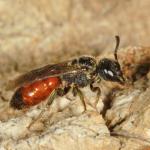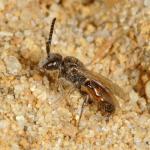Sphecodes variegatus HAGENS 1882; Sphecodes divisus HAGENS 1882; Sphecodes valesianus FREY-GESSNER 1903
This bee strongly resembles Sphecodes geoffrellus (Kirby) and S. miniatus von Hagens and is sometimes best identified from the male genitalia. It has been recorded more frequently in the last two decades.
Found from the Isles of Scilly to Kent and north to Yorkshire and Northumberland. Also from Wales and one out-lying location in Scotland, near Edinburgh. It is present on the Isle of Man, where a large form has been found.
Abroad, a Palaearctic species found widely throughout most of Europe and north Asia as far east as Mongolia.
Listed in Falk (1991) as Notable B (now known as Nationally Scarce). In view of the increase in frequency of recording, this status probably now needs to be reviewed.
Recorded from the same habitats as its hosts, including heathland, calcareous grassland, disturbed locations such as quarries, and coastal soft rock cliffs.
Univoltine. The female flies from early April to early September and the male from mid June to late September.
The female is a cleptoparasite of mining bees of the genus Lasioglossum. It has been found in association with L. nitidiusculum (Kirby) and possibly L. parvulum (Schenck). Abroad, it has been reared from L. pauxillum (Schenck). As this latter bee has increased in frequency in Britain, so has S. crassus. Details of the parasitic behaviour have apparently not been observed.
The females have been found visiting wild angelica (for nectar only), whilst the males have been recorded from Apiaceae such as hogweed and wild carrot (G A Collins, pers. comm.), ling, mayweed and other Asteraceae (Falk, 1991).
No data available.
2019



